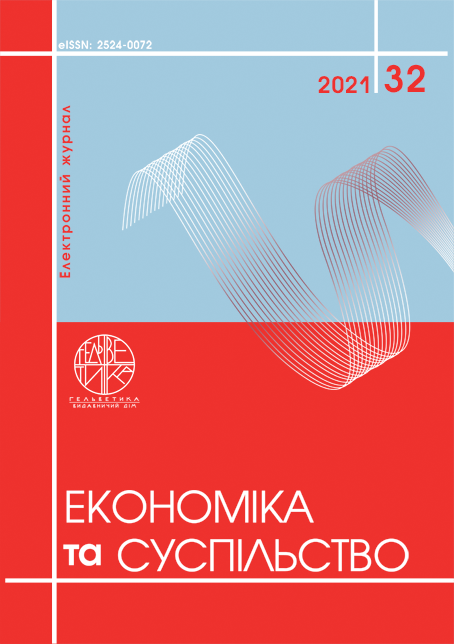FORMATION OF THE CIRCULAR ECONOMY INDEX FOR COMPARATIVE ANALYSIS OF THE EUROPEAN COUNTRIES TRANSITION TO THE CIRCULAR ECONOMY
Abstract
The article is devoted to the topical issue of analyzing the level of transition of the European Union countries, United Kingdom, Norway and Ukraine to a circular economy. Given the lack of a unified methodological approach to measuring the indexes of the process of the circular economy implementation at the national and global levels, in the article there was used the authors’ approach to create a circular economy index based on 13 indicators, which are grouped in 4 clusters, namely production and consumption, waste management, secondary raw materials and competitiveness and innovation. The analysis of each 13 indicators was carried out, the index of circular economy implementation for 2010-2018 years was calculated and the ranking of countries on degree of circular economy realization was carried out. The best results in the implementation of circular economy were achieved by Germany, United Kingdom, the Netherlands and France. On the other hand, Malta, Greece, Cyprus, Croatia and Ukraine received the worst results. Latvia (+10 positions), Slovenia (+8 positions) and Belgium (+6 position) have shown the greatest progress in advancing to circular economy. At the same time, the biggest regress was shown by Luxembourg (-10 positions) and Norway (-9 positions). Based on the obtained results, a correlation analysis was conducted between the circular economy indicator and the global competitiveness index. Consequently, Pearson’s correlation test indicated a positive correlation between the circular economy index and global competitiveness index. The correlation coefficient is 0,665. Germany, the United Kingdom, the Netherlands, Belgium and Austria are among leaders in the implementation of circular economy and the level of competitiveness, while Ukraine, Bulgaria, Cyprus, Malta, Greece, Romania and Estonia are among outsiders.
References
Вернадський В. Декілька слів про ноосферу. Хроніка. Київ. 2004. Вип. 57/58. С. 485–495.
Stahel W. (1981). Jobs for tomorrow: the potential for substituting manpower for energy. New York. 116 р.
Boulding K. (1966). The Economics of the Coming Spaceship. Environmental Quality Issues in a Growing Economy. Балтимор: Johns Hopkins University Press. Р. 3–14.
Євдокимов В.В. Циркулярна економіка. Монографія. Житомир : ЖДТУ, 2016. 200 с.
Мусіна Л.А. Ресурсоефективна економіка: європейські тенденції та уроки для України. Економічний аналіз. 2014. Том 18. № 1. С. 51–62.
Eurostat. URL: https://ec.europa.eu/eurostat/web/main/data/database
Державна служба статистики України. URL: http://www.ukrstat.gov.ua/
OECD statistics. URL: https://stats.oecd.org/#
World Bank. URL: https://data.worldbank.org/
World Economic Forum (2018). The Global Competitiveness Index. URL: http://www.uaeconomic.com/ulens-313-1.html
Vernadsky V. (2004) Dekilʹka sliv pro noosferu. [A few words about the noosphere]. Khronika. Kyiv. Issue. 57/58. 485–495. (in Ukrainian)
Stahel W. (1981) Jobs for tomorrow: the potential for substituting manpower for energy. New York. 116 p.
Boulding K. (1966) The Economics of the Coming Spaceship. Environmental Quality Issues in a Growing Economy. Baltimore: Johns Hopkins University Press.
Evdokymov V. (2016) Tsyrkulyarna ekonomika [Circular economics]. monohrafiya [a monograph]. Zhytomyr: ZhSTU. 200 p.
Musina L.A. (2014) Resursoefektyvna ekonomika: yevropeysʹki tendentsiyi ta uroky dlya Ukrayiny [Resource efficient economy: European trends and lessons for Ukraine]. Economic analysis. Volume 18. № 1. 51–62.
Eurostat. Available at: https://ec.europa.eu/eurostat/web/main/data/database
State Statistics Service of Ukraine. Available at: http://www.ukrstat.gov.ua/
OECD statistics. Available at: https://stats.oecd.org/#
The World Bank Data and Research. 2021. World Bank Statistics Database. Available at: https://data.worldbank.org/
World Economic Forum. 2018. The Global Competitiveness Index. Available at: http://www.uaeconomic.com/ulens-313-1.html


